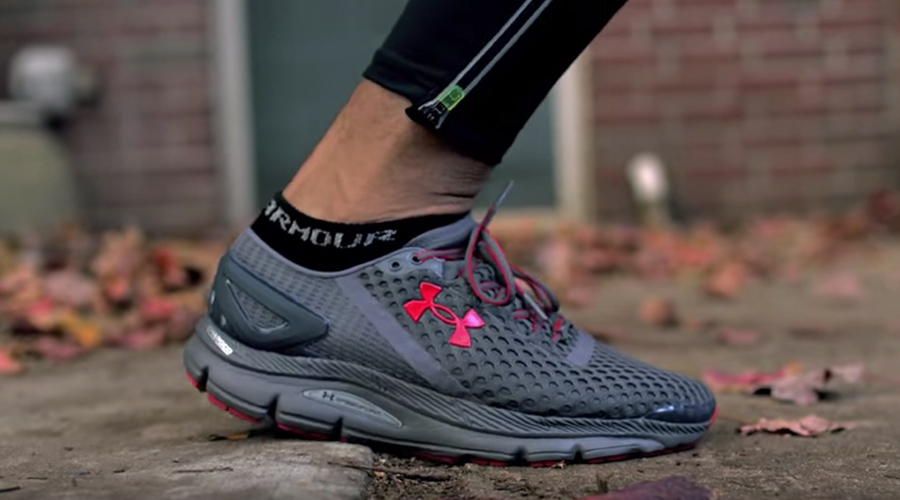The latest implementations aren’t wooing us. Here’s what we want.
By Jahla Seppanen
We get it — athletes (and brands) want data.
It can be great to know when you hit that mile-mark, current pace, or if that new sports drink made a difference. Consumers revel in analyzing their stats to adjust and improve performance for the next go-around.
Brands like the data, too. They see how their buyers are performing and using product, and can sell that information to data-hungry companies looking to track trends.
Hence the boom in fitness-tracking and GPS watch sales, and with it the pipe dream of what designers can make “smart” tomorrow.
The recent buzz has been around the “smart shoe.”
In late February, Under Armour released its SpeedForm Gemini 2 shoe, $150, which tracks and stores running metrics — time, cadence, duration, distance, splits, GPS — which syncs to Under Armour’s MapMyRun data platform. Sounds cool in theory, but consumers have responded with the common response, as one reviewer summed, “very comfortable but cannot connect.” All we know is if you’re marketing a tracker it better track, but even this proves to be a challenge in smart footwear.
Fast-forward to early June, when Chinese computer brand Lenovo touted its smart-shoe prototype technology, released at the company’s Tech World gathering in San Francisco, CA, and purportedly powered by Intel Curie — a tracking chip the size of a button.
Lenovo’s smart shoe prototype will track steps, calories, body fat and sweat via a 3D printed insole. They remain charged for about a week and a half if you’re just walking around or up to 10 hours if you’re running hard. Recharge sans wire by placing the shoes on a small mat. For fitspiration, wearers can sync into a mobile game that turns the kicks into a joystick. After all, one of the biggest trends in fitness right now is finding ways to trick the user into being more active, translating steps to coins or miles into whether you would escape a zombie apocalypse (as done in the app Zombies, Run!). Oh, and the bottoms light up, which is cool if you’re a night runner. The design is comparable to a low basketball shoe and was shown in all red and all white models.
But seeing and hearing about the latest smart shoes has honestly left us runners here at SGB a bit underwhelmed. We’re wondering if any brand can come out with a fit-tracking shoe that really has what we want.
Whether its adding functionality, vogue style details or more options to gamify through compatible apps, we predict it will be difficult to transition the smart shoe into the wearable market because its current honchos are dominating sales (cough, Fitbit).
From the consumer perspective, if a wearable smart shoe were to come to the market, here’s what we’d like to see.
- First of all, tracking steps (we prefer miles) shouldn’t be a selling point; by now it’s expected. A truly smart shoe should also tell us when the shoes should be replaced — either by miles or by sensing that the shoe’s performance structure has been compromised.
- We’re also looking for a smart chip that can either be used interchangeably with different shoes, or is pretty cheap, otherwise it would be hard to rationalize the extra money for a tracker we have to toss in six months.
- Pronation is another stat that would be extremely helpful. We wouldn’t want hourly updates but an evolution over time (weekly or monthly) to see if our running placement has alternated, perhaps leading to that sore peroneal tendon last week. Of course pace, steps and cadence are fundamental to run tracking, although we’d be fine skipping the calories burned. A mile’s a mile.
- The next essential is the right shape. Footwear is tricky because the shape of a shoe can dictate its use. We want a smart shoe that can transition from speed intervals on the track, to a quick hike, then a casual dinner. Nowadays consumers are doing it all, so the footwear has to follow suit. We would opt for a plain design that doesn’t have a bulk of padding, nor a super-thin bottom. Lights on the bottom would be fun, but maybe we’ve been prone to desire the theatrics of “futuristic shoes,” or just can’t shake the stomp-and-light sneakers we had growing up.
- Sweat tracking doesn’t seem too important, unless the shoes are strictly for performance use. You don’t need it for fun fitness though — just another excuse to buy sugary sports drinks.
In the end, expectations for a smart shoe may prove too high to accomplish. Even Under Armour has struggled to get more than a three-star rating for its Gemini 2s online. This may all be a result of consumers tiring of trackers. According to SSI Data* Activity Tracker sales at industry retail are down a little more than 10 percent over the trailing 52-week period, while GPS watches are slumping roughly three times that amount.
That being said, if brands plan to debut a smart shoe in 2016, they should slate the release for the end of the year. Tech product releases have historically gained more dollars during the holiday shopping season.
*SSI Data, powered by SportsOneSource, collects and analyzes POS data from more than 15,000 retail doors across nine channels of distribution. To learn more call 303.997.7302 or email Solutions@SportsOneSource.com.
Photo courtesy Under Armour











